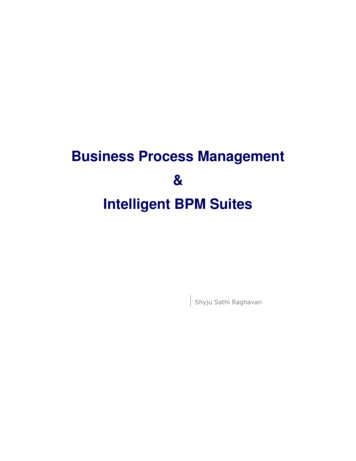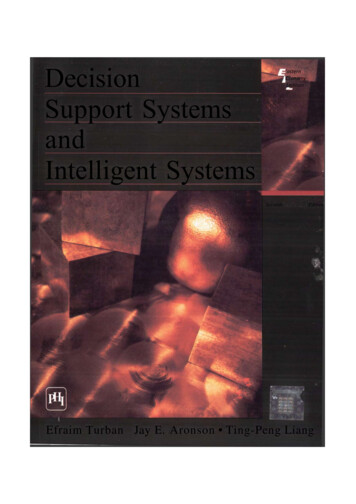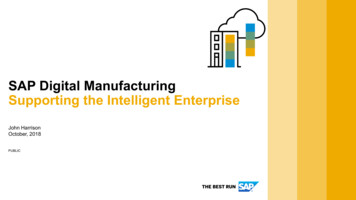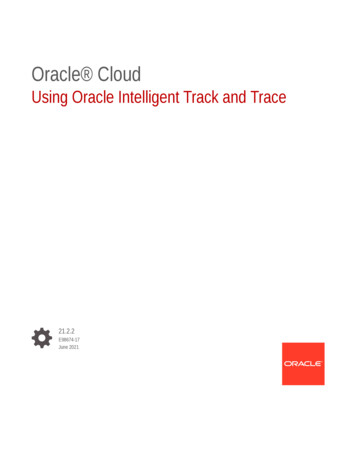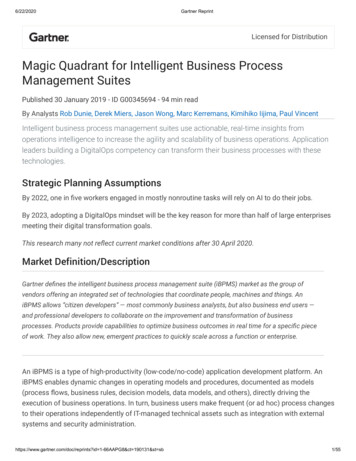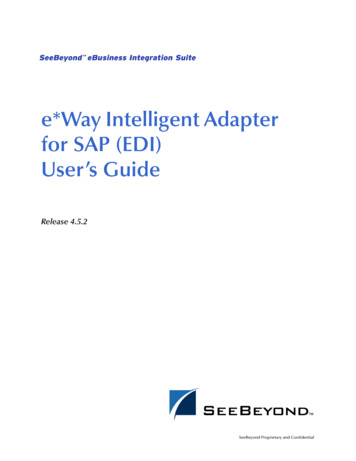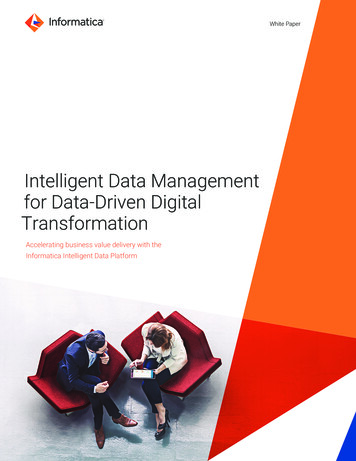
Transcription
White PaperIntelligent Data Managementfor Data-Driven DigitalTransformationAccelerating business value delivery with theInformatica Intelligent Data Platform
ABOUT INFORMATICADigital transformation changes our expectations: better service, faster delivery, greater convenience, withless cost. Businesses must transform to stay relevant. The good news? Data holds the answers.As the world’s leader in enterprise cloud data management, we’re prepared to help you intelligently lead—inany sector, category or niche. To provide you with the foresight to become more agile, realize new growthopportunities or even invent new things. With 100% focus on everything data, we offer the versatility youneed to succeed.We invite you to explore all that Informatica has to offer—and unleash the power of data to drive your nextintelligent disruption. Not just once, but again and again.
Table of ContentsIntroduction.4What Is Digital Transformation?.5Data Management Challenge.6Generational Shifts: Types of Data Management Initiatives .7Digital Transformation Customer Examples.8How Informatica Helps: The Intelligent Data Platform.9Drill-Down: Enterprise Data Catalog. 11The Intelligent Data Platform Supports the World of Cloud and On-Premises. 12Conclusion. 14Intelligent Data Management for Data-Driven Digital Transformation 3
IntroductionDigital transformation is both a business opportunity and a strategic threat. The opportunitycomes from leveraging analytics and new business models, fueled by data. The threat comesfrom competitors emerging from multiple directions with new business models that target yourbusiness. Digital disruption is changing the competitive landscape at an unprecedented rate. It isa matter of transform or be disrupted.Data is the currency of digital transformation. The success of your business strategies dependson making all your data available as a shared resource to your entire organization.Those who succeed in this new landscape will be the ones who lay a flexible and adaptivefoundation of data management to deliver trusted data for all new business models, newanalytics, and new users across the entire organization.Intelligent Data Management for Data-Driven Digital Transformation4
What Is Digital Transformation?Digital transformation is the process of creating new digital business processes and businessmodels to give an organization a competitive advantage, allowing them to make better decisionsand deliver a higher level of service to customers. In the Data 1.0 era, data was held in specificapplications that often became application “data silos.” In the Data 2.0 era, data began to be usedin business processes between applications. Now with Data 3.0, data is being used as the fuel fordigital transformation, enabling new business models, better decisions, and faster innovation.Here are some examples: All-digital banking and insurance: New financial services companies are emerging that haveno legacy systems, no merger and acquisition system complexity, and no physical offices.Their agile use of client data allows for more detailed views of the customer’s needs. Personalized healthcare: Providers are applying analytics to patient and genomic data tohighly personalize approaches to healthcare. Sensors: Sports equipment and clothing are equipped with sensors to collect data about theuser that provide immediate feedback on athletic performance, potential for injury, productusage, and more. Autonomous cars and ride sharing: These emerging business models could cause a revenuedecline of up to 40 percent in automobile sales in the next few years.1 Shaving: A recent startup is offering low-cost men’s shaving products on a subscription basisby mail. This simple business model is having a significant effect on the shaving industry.Clearly, new thinking is required: Offensive thinking: Leading organizations are thinking of how to use new business modelsthat lead their own disruptions through data. KPMG found that “60 percent (of CEOs) seetechnological disruption as more of an opportunity than a threat.” It also found that the topCEO priority was improving “speed to market.” 2 Defensive thinking: Watching from the sidelines can be dangerous and doesn’t takeadvantage of the disruptive power of data. Competition can come from across industryboundaries (e.g., autonomous cars) or from entirely new startups (e.g., online banking).At the very least, you will need to monitor the competitive landscape carefully. If it takes yourorganization years to respond to a new competitive business model, the damage may beirreversible.12“Driverless Cars May Cut U.S. Sales by 40%, Barclays Says,” Automotive News, rcent-barclays-says.“U.S. CEO Outlook 2017: Disrupt and Grow,” KPMG, 17/06/2017global-ceo-outlook.pdf.Intelligent Data Management for Data-Driven Digital Transformation5
Data Management ChallengeAre you having trouble getting traction with new transformative initiatives? You are not alone.McKinsey reports that 86 percent of surveyed executives reported that they were “at best, onlysomewhat effective at meeting the primary objective of the data and analytics program.” Theprimary technical reason for this failure is the lack of data management.3Data management is a challenge due to the number of requirements: Discoverable data: Internal data is typically locked up in application data silos. For decades,data has been attached to enterprise applications and was never designed to be sharedacross the organization. Scalable solutions: The growth of data volume, variety, and velocity is well-documented. IDCestimates that the amount of data generated is doubling every two years.4 Consistent quality: Analysts estimate that 50 percent of data is coming from sources externalto the organization: This data often comes in many formats and quality levels and with little orno business context attached. Self-service access: There is huge growth in new types of users such as business analystsand data scientists who want and need access to data and expect self-serve access. New use cases: Digital transformation is driving new business models that require data frommany new internal and external sources to derive value in terms of customer understanding ordecision-making.Leadership in data-driven digital transformation requires a new approach to data management:Data must be viewed as a shared resource, immediately discoverable and usable by all.Architectures need to be designed data-out rather than application-back. Applications will comeand go. What differentiates a strategy is your data and how you use it.Architectures need to be designed for change. We are experiencing unprecedented technologychange at all levels of the stack. It must be able to quickly adapt to change with minimal impactfrom: New data sources New use cases New technologies such as big data, cloud, etc. New user types Support for both traditional data use and rapid experimentation for innovation Business users must be enabled to manage and self-serve data for their needsIT groups that can build this type of plan will be in a much better position to participate in theformation of strategy with their organizations rather than after the fact.34“The Need to Lead in Data and Analytics,” McKinsey, April 2016, -analytics.“The Digital Universe of Opportunities,” IDC, 14iview/executivesummary.htm.Intelligent Data Management for Data-Driven Digital Transformation6
Generational Shifts: Types of Data Management InitiativesDigital transformation at the business level is driving significant new data-driven initiatives tosupport new business models. We refer to these business initiatives as “journeys” because mostorganizations cannot afford to just start over. More often, it is a case of implementing new datainitiatives incrementally. At first, the following initiatives may augment current systems, but overtime, they will probably expand and ultimately replace them: Journey to cloud and on-premises: Organizations move to cloud because of the speed in“standing up new projects,” flexibility, cost, and, security. But for most large organizations,this means they will be managing an on-premises and cloud environment for years to come.Most customers are also finding that they need to manage multiple clouds: platforms andapplications. This increases the challenge of keeping data accessible, secure, and relevant. Journey to next-generation analytics: Organizations expand on their current datawarehouse/business intelligence environments and augment them with intelligent data lakes,predictive analytics, and artificial intelligence (AI). This also increases the data challengecomplexity as there are more analytics systems being used for different purposes that allneed to be fueled with trustworthy and relevant data. Journey to data governance and compliance: Data governance has grown beyond regulatorycompliance to include data governance for better analytics and business processes. As databecomes the currency of digital transformation, organizations need enterprise-wide datagovernance to ensure trusted, timely, and actionable data for management decisions andbusiness processes. It is becoming increasingly critical to secure the veracity of data thatproliferates across the organization. Journey to analytics data self-service: As more organizations build analytics into theirapplications and processes and look to enable business units to use analytics to driveinnovative new business insights, the need grows for analysts to be able to self-serve theirown data. This data needs to be “fit for purpose” in terms of trust levels where “good enough”data might be OK for rapid innovation but trusted data will be required when operationalizingkey decision-making processes. Journey to 360 engagement: As master data management (MDM) matures, organizationsare moving beyond simple customer master records to mastering and relating much moredata about their organizations. They are using this data to drive business initiatives such asdeeper customer engagement or stronger supplier management. Some of the new data beingcollected for these purposes includes New domains: They are adding additional related data domains such as suppliers andpartner data. New data types: They are adding much more data about each domain, such as transactiondata, relationship data, interaction data, sensors, and Internet of Things (IoT) data.Intelligent Data Management for Data-Driven Digital Transformation7
Digital Transformation Customer ExamplesIf building a data foundation for digital transformation sounds challenging, it is. Here are fourbusinesses that are disrupting their markets with data-driven digital transformation:1. JLL (formerly Jones Lang LaSalle) is transforming commercial real estate. The businessis using data and analytics to provide an array of services to its customers that enable thecompany to be more of a strategic partner. These services include optimal site selection,building security management, HVAC management, power management, conference roomdesign, and property portfolio management. JLL combines a great deal of data from externalsources with internal data to provide a higher level of value to its customers.2. Cleveland Clinic is transforming the delivery of healthcare. The healthcare organization haslong been a leader in its use of data warehousing and business intelligence but recentlylaunched a predictive analytics initiative. To start, the organization expanded its datagovernance practice to ensure that the data was trusted. Then it built systems to predict upto eight weeks out for its more than 100 operating rooms and all upstream and downstreampatient care needs. In that way, Cleveland Clinic is working to ensure the right people andresources are in place at every stage to address each patient’s healthcare needs.3. Nordstrom has consistently been recognized as a customer service leader. Nordstrom’srecent efforts to use data and analytics to better understand and engage with its customersare resulting in high levels of customer loyalty and more return shoppers, across all saleschannels.4. Tinkoff Bank is one of the largest credit card issuers and fastest growing banks in Europe.The bank has accomplished this by building an all-digital business model that leveragesdata and analytics to better understand customers, innovate rapidly, and monitor fraud. Itsarchitecture ensures 100 percent of the bank’s data is available to employees for ad hocreporting, dashboards, and decision-making.Intelligent Data Management for Data-Driven Digital Transformation8
How Informatica Helps: The Intelligent Data PlatformThe Informatica Intelligent Data Platform (IDP) is designed to meet the needs of customers’digital transformations. It’s the industry’s most complete and modular solution that helpscompanies unleash the power and value of all data across the enterprise: Built for a world of on-premises, cloud, and big data anywhere. Modular, letting you start small and grow at your own pace. Many of our most sophisticatedcustomers have started with a single product. AI-driven, including the CLAIRE engine that provides built-in intelligence and automation byleveraging Informatica’s leading metadata capabilities across the platform. Microservices-based, enabling Informatica to deliver data management innovation faster andto allow the IDP to be easily integrated via open APIs into customer environments. Complete, the IDP provides an end-to-end solution built from products that are all industryleaders in their spaces. Management and governance, for all things data, from mainframes to IoT, at any speed.The IDP delivers data that is trusted, timely, and actionable for any data-dependent use case.The Informatica Intelligent Data Platform is made up of the following products and solutions:Figure 1: Unlock data’s potential with the Informatica Intelligent Data Platform.Intelligent Data Management for Data-Driven Digital Transformation9
ProductsThere are six product areas within the IDP. Each product area contains multiple products: Data Integration: To move, transform, and integrate data Big Data Management : To manage very large data sets with complex data structures Cloud Data Management: To provide software as a service data management capabilities inthe cloud that can manage data anywhere, referred to by Gartner as integration platform as aservice (iPaaS) Data Quality: To ensure that the data is trustworthy for decisions and business processes Master Data Management: To provide a related and trusted 360-degree view of data fordomains such as customer, supplier, or product Data Security: To ensure that your sensitive data is protectedSolutionsThe solutions run on top of the products and provide business-appropriate user interfaces toenable business users to self-serve data and to take an active part in managing the data.The IDP integrates products and solutions to provide the following capabilities: CLAIRE intelligence: With AI and metadata-centric intelligence across the IDP, productsand solutions gain intelligence to provide suggestions, recommendations, and automationof tasks such as discovering data, tagging data, and recognizing data entities and domains.CLAIRE automatically detects the structure in new unstructured data and creates mappingsto onboard similar data in the future. CLAIRE metadata-centric intelligence will be increasinglyintegrated with all the capabilities of the Informatica Intelligent Data Platform to automatetasks and boost overall productivity. Informatica Operational Insights: This machine-learning-based analytics tool providesmonitoring and management of all products across the IDP. Compute: The IDP automatically selects the optimal compute engine for big data jobs basedon the requirements of the job from MapReduce, Spark, Tez, and Blaze engines. Connectivity: All products on the IDP share connectivity to all data sources on-premises,cloud, or big data, anywhere.Intelligent Data Management for Data-Driven Digital Transformation10
Drill-Down: Enterprise Data CatalogInformatica Enterprise Data Catalog (EDC) provides a critical starting point for almost any datarelated project and enables any user to discover and manage any data in your enterprise—that’sany data.EDC collects metadata on all the data in your organization: traditional structured data, Word docs,PowerPoint, PDFs, flat files, big data, cloud data, applications data, and data from other nonInformatica Extract Transform Load (ETL) sources. You will get one view of all your data.You could sum up EDC this way: “Google-like search with Amazon-like recommendations.” Theresult is that developers, business analysts, data scientists, and others can quickly find andmanage the data they need. This represents a savings of up to 50 percent of the time spent doingdata discovery and preparation.Figure 2: Informatica Enterprise Data Catalog automatically catalogs and classifies all types ofdata across the enterprise.EDC also provides capabilities such as data lineage diagrams, impact analysis, data tagging, dataclassification, annotations, data recommendations, and more.Intelligent Data Management for Data-Driven Digital Transformation11
The Intelligent Data Platform Supports the World of Cloud andOn-PremisesInformatica has provided industry-leading cloud products for more than a decade. Over time,the definition of a cloud integration platform has evolved to become the iPaaS definition. Thisincludes the following functionalities: Cloud data integration (ETL capability) Application and process integration API management ConnectivityInformatica Intelligent Cloud ServicesSMsignificantly expands the potential scope of iPaaS andincreases the value delivered. This latest development is a direct response to customer feedback.Customers need a complete and integrated platform that can manage data across multipleclouds, on-premises, and big data, anywhere.Informatica Intelligent Cloud Services includes everything in the traditional definition of iPaaS pluscapabilities such as: Cloud B2B Cloud Integration Hub (unique in the industry) Cloud Data Quality Cloud MDM Cloud Data Security Cloud Data Lakes and Internet of ThingsInformatica is a recognized leader in the Gartner Magic Quadrant for iPaaS. With InformaticaIntelligent Cloud Services, Informatica is reimagining iPaaS and delivering a solution that is morecomprehensive than anything else currently available in the cloud marketplace.Figure 3: Informatica Intelligent Cloud Services automates data migration and integration.Intelligent Data Management for Data-Driven Digital Transformation12
Informatica Intelligent Cloud Services is a “cloud of clouds.” It is an instantiation of theInformatica Intelligent Data Platform in the cloud that includes cloud capabilities for our DataIntegration, Data Quality and Governance, Master Data Management, and Data Security products.Additional clouds will be added over time.While Informatica Intelligent Cloud Services functions as the IDP in the cloud, there are somedistinct additional features specific to the
boundaries (e.g., autonomous cars) or from entirely new startups (e.g., online banking). At the very least, you will need to monitor the competitive landscape carefully. If it takes your organization years to respond to a new competitive business model, the damage may be . Nordstrom
